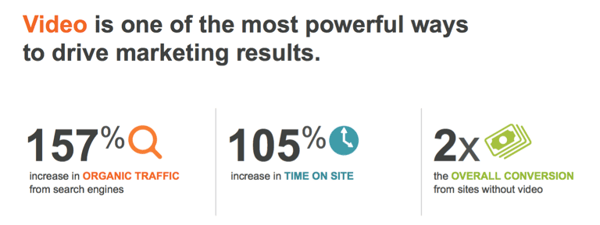How To Use Video Marketing To Increase Engagement With Blog Posts

Summary: It might be time to increase your video marketing efforts if you are looking for ways to increase engagement with your blogs. Read more here.
As you gear up for the new year, now is the perfect time to take a look at ways you can improve your content marketing strategy. Are you looking for ways to take your business’ blog to the next level? Now is the time to look into using video marketing to increase engagement with your blog posts.

First and foremost, there are many ways to use video to ignite your marketing campaigns. One of those ways is with video content, which is everywhere and there is a high demand for it from consumers of many brands and businesses.
Why Use Video Marketing to Increase Engagement With Your Blog Posts?
As a marketer, you need to understand how your consumers or audience absorb your content. How do they read your blog? Do they read it word for word? Do they skim and just scan it? What is the average amount of time a reader spends on each blog post? As direct as these questions may seem, understanding consumer and audience behavior is crucial, especially when it comes to creating content and increasing engagement.
Videos help break up the text in your blog posts.
We now live in a digital age where attention spans are becoming shorter, and the first 10 seconds are the most crucial part of capturing your reader’s attention online. These are the moments when your visitor makes the decision whether to continue browsing through your website for additional information or leave and proceed elsewhere. According to a 2013 study by Medium, the optimal blog post is about 7 minutes long, which translates to around 1,600 words in length. More recently, however, that length has been creeping up. A 2020 survey of 1,279 bloggers by Orbit Media found that web content of 3,000 words or more is most likely to yield strong results. The survey revealed that posts over 1,500 words begin to perform above average.

To help overcome this inevitable truth of readers merely scanning through webpages, articles, and blog posts, using visual content such as videos can help break up the text in your blog posts. It’s time to let go of those lengthy paragraphs and cut down on the text. Use shorter sentences, be more concise, and utilize visuals. Why? Because videos stand out and attract readers. When people are scanning through a copious amount of text, they are most likely to stop at the images. They are also more likely to skim the lines right before and right after the visual to absorb main points.
Videos increase the time spent on your blog posts.
This study by Oracle suggests that videos can increase the time spent on your webpage by more than 100%. When you include videos in your blog posts, readers will feel more inclined to stop when they reach the video. More often than not, readers will end up engaging with the content by clicking on the video because it stands out in the midst of all text in the blog post.

Videos attract Millennials
A lot of online content is being absorbed by Millennials, one of the most tech-savvy generations of our digital day and age. But one generation that trumps them all when it comes to both digital fluency and dependency is Gen Z.
This generation has never known a world without the internet as they were born into a world that was already online and the foundation of today’s digital ecosystem was already visible. As such, this generation sees the web as the starting line, and it is an intrinsic part of their everyday lives. Given this omnipresent role of connected technology, Gen Z’s expectations for the digital landscape far exceed that of any generation that has come before them. The average Gen Z member has an online attention span of eight seconds, which is four seconds less than millennials. But although Gen Z’s attention span for general online surfing might be quite short, long-form videos that interest them can grasp their attention — and keep it, so they are definitely an audience to keep in mind when it comes to using videos to increase engagement with your blog posts. Videos are a major driving factor of both Millennials and Gen Z consumer behavior, and much of their buying decisions result from watching video content.
How Should You Use Videos to Increase Engagement With Your Blog Posts?
We’ve discussed the “why”, so now we’ll discuss the “how”. There are a number of ways you can use video content to increase engagement with your blog posts.
1. Create original video content
Creating original and authentic video content and embedding videos into your blog posts will help increase the overall engagement of your posts.
Types of content to consider:
- An ‘About Us’ video
- Tutorials and How-To Videos
- Video Summaries
- Vlogs
- Client Reviews and Testimonials
By including original video content into your blog posts, readers will more likely share and engage with your posts. Original videos tell a story. When you become a master at storytelling for your business and create compelling content, people will be more inclined to like, comment, and share it with their network.
2. Keep videos under 2 minutes
If you’re looking to use videos to increase engagement with your blog posts, make sure the videos are short and straight to the point. Short videos gain the most engagement. According to HubSpot, the most engagement is seen when videos are about 2 minutes long. You may be thinking, “a 2 minute video seems a little short for all the information I want to include.” Don’t worry about having to explain and go too in-depth to cover all aspects of the topic surrounding your blog post. Using videos in your blog posts is meant to complement the information being discussed, not cover the post in its entirety.
3. Host your videos on YouTube
There are typically two ways you can go about hosting your video content online: on your own website or on YouTube. Personally, I would recommend hosting videos on YouTube before embedding them into your blog posts. This is because YouTube offers a wide range of SEO and analytics tools which help track engagement.
Blogging platforms such as WordPress make it extremely easy to embed YouTube videos into your blog posts. Simply hop into the backend of your website, and when you are looking to attach any visual media, you have the option to directly paste the URL of the video you want to attach and it will appear in your post.
When done right, YouTube has the potential to bring in hundreds, thousands, or even millions of new customers to your business. Embedding YouTube videos into your blog posts can help bolster your overall SEO and help your business rank higher when people are searching for content.
4. Repurpose existing video content
If you already have an existing YouTube channel or a content hub with existing video content, repurposing videos is another excellent way to increase engagement with your blog posts. One thing to keep in mind is to make sure that the video you are embedding is relevant to the topic of the blog post.
Online Video Tools
There are many useful tools online to help you make the best videos for your digital content marketing. Some options are:
- free/paid
- simple/complex
- for creation/editing
- designed for video footage/images/animation
Screencasting (Vidyard)
Screencasting is when you narrate a video recording of your computer screen. Sometimes it is just audio, and sometimes you can see your face in the video as well. One free tool that is particularly useful is Vidyard. One of the many advantages of this tool is that it allows for a versatile way of using video to share tutorials as a screencast by narrating digital creations.
Make Your Post Into A Video (Lumen5)
Lumen5 is a simple way to make a slideshow-type video. It can even automatically make your blog post into a video. Lumen5 contains a library of Creative Commons Zero images and music, so you do not need to search for content either. However, to share the video you will have to post it on social media or YouTube first and then get the embedded code from there. Or you can download the video and upload it directly into your post.
Offline Video Creation
You can make videos in the traditional way too, and you do not need any fancy equipment either — a cellphone, tablet, or webcam can work just fine! Here are a few ideas that might work for your blog posts:
Piece-To-Camera
The idea of getting in front of a camera can be very daunting, and most people would prefer to avoid it altogether. However, it can be a really great way to connect with customers. You could even create an occasional piece to camera for special occasions like welcoming customers at the start of a new year/event or thanking your customers for their support at the end of the year and wishing them happy holidays.
10 Filming Tips
There are several things you can do to enhance the quality of your piece-to-camera.
- Lighting: Sit near a window or add lamps if you can.
- Audio: Add an external mic if possible.
- Tripod: Keep your device steady.
- Location: Find a quiet spot with a simple background.
- Lens: Wipe that dirty lens before you start.
- Horizontal: Turn your phone sideways.
- Height: Raise your device to eye level.
- Camera: Switch the camera so you can see yourself.
- Eye contact: Look at the tiny camera hole. Smile!
- Record: Aim for a natural approach.
Interviews
Interview videos provide relevant information for both your audience and your guest’s audience, but they are also a powerful addition to your social media strategy. These interviews should be conversational yet intriguing.
A note on green screens
Having a green screen as your backdrop can work great when shooting instructional videos, as you can use editing software to replace the green color with different backgrounds. This chroma key effect allows you to place objects behind and in front of you. It can help your videos look slick and put a focus on your content.
A Note On Editing Software
While it is not always essential, you will generally want to do some basic editing, such as adding text titles or captions, adding music, chopping out certain parts of the video, or mixing together video and images. QuikStories (available in iOS and Android) and Splice are two free apps from GoPro that are great for quick video editing on your phone. QuikStories puts it all together for you with music, transitions, and other cool effects, while Splice is useful if you want to make more manual edits and do not necessarily want too many effects.
Types of Video Content to Add to your Blog
Video marketing is not as complicated as it may seem. It is about getting familiar with what video content people love to watch—and then offering more of that. Here are eight engaging types of video content that can help you build brand awareness, captivate your audience, and influence customers to take action.
1) Vlog
While blogs are great, vlogs, or video blogs, are much better. Vlogs offer you a cost-effective platform to establish a unique brand voice and personable image that resonates with your target market. It is inexpensive and easy to shoot a short, off-the-cuff vlog with nothing more than your smartphone or webcam. This authentic approach gives your video content a relatable, personalized quality instead of a super-slick, corporate production.
2) Behind-the-Scenes/Company Culture
Compelling brand storytelling can set your company apart from its competitors, simultaneously motivating employees and captivating prospects. For this reason, one of the best types of video content you can use is a behind-the-scenes video that reveals your company culture. This type of video offers an immersive experience, pulling back the curtain on your company to allow customers to forge a connection with your brand. In essence, a behind-the-scenes video enables you to breathe life into your brand, humanizing it to appeal to viewers on a personal level.
3) Interview/Q&A
Interview videos are ideal for building brand authority as they allow you to align your brand with thought leaders and inspirational figures, help you establish authority with input from respected voices, and give your audience an intimate 1-on-1 experience where someone in your business or market space answers hard-hitting questions.
4) Product Reviews
Product reviews are among the most valuable types of video content, especially for consumers in the consideration phase of the customer journey. These videos work best when you have already established some trust with your audience. By reviewing products, you can answer common questions, dispel doubts, and show viewers the unique benefits that your product offers, which give prospects all the information they need to make purchasing decisions. A product review video can be only 30 seconds long and get the brand message and product benefits across loud and clear—without using a single word.
Even if your business operates a B2B model with only one product, like a SaaS company, you can still do product reviews of related products or services that are not in direct competition. By recommending quality products that are compatible with your own, you can enhance the customer experience of your products and services, effectively boosting customer satisfaction.
5) Testimonials
While blogs, presentations, and product reviews are all excellent types of video content, creating video testimonials is a clever way to take each of them to the next level. By putting the spotlight on existing customers, you can show viewers just how happy your brand (and its products and services) makes people. The key factor here is to get real customers. Reach out to your satisfied customer base and create genuine video testimonials. The best way to persuade potential customers to buy in on what you offer is by asking your current customers to convince them.
6) Live-Streaming
Live-streamed videos are the norm on many channels. Whether it is breaking news headlines, sports, or exclusive announcements from someone influential, a live-stream video has a magnetic allure. Once again, this comes down to FOMO. Live videos create the suspense of not knowing what will happen next to make customers feel they will miss something if they do not tune in. Another unique edge of this form of video marketing is that live videos allow real-time community interaction. You can use them to broadcast an assortment of video content, including new product launches, live Q&A sessions, or a behind-the-scenes look at an event.
7) User-Generated Content
Inviting customers to contribute videos is a clever way to get customer testimonials. But it does not need to stop there. User-generated content is huge now, and you can leverage it in various ways to drive traffic, gather leads, and build brand loyalty. An excellent way to take UGC to the next level is by partnering with an influencer.
8) Personalized Videos
Marketing used to be all about making the sale. Now, it is all about the customer. Businesses need to show they understand their audience and care about their needs and interests. To use personalization in video marketing, you need to forge a connection by personalizing the video for each viewer.
Video FAQs
What does a blog need for video?
- Adequate recording gear (quality microphone and video camera)
- Video editing software
- Social platform suited for video content distribution
- WordPress plugins
- Reliable web hosting service
- YouTube account
How do you embed a video in a blog post?
You embed a video using a URL as follows:
- Copy the video’s URL from your web browser’s address bar while viewing the video. For YouTube videos, you can use the video URL from “Share this video” under the Share option.
- Go to Posts > Add New.
- Paste the URL on a line by itself in your post editor where you want the video to appear.
You can also embed videos using the embedded code:
- Locate the video you want to embed.
- Copy the embed code for the video.
- Go to Posts > Add New.
- Place your cursor where you want the video to appear, and then click on the Add Media button.
- In the Add Media window, click on the Insert Embed Code tab.
- Paste the video embed code into the embed code field.
- Click on Insert into Post.
- Your Add Media window will close, and the form will appear in the visual editor.
What is meant by micro blogging?
Micro blogging is an online broadcast medium that exists as a specific form of blogging. A micro blog differs from a traditional blog in that its content is typically smaller in both actual and aggregated file size. Micro-blogs allow users to exchange small content elements such as short sentences, individual images, or video links which may be the major reason for their popularity. These small messages are sometimes called micro-posts.
Micro blogging is a fast way to get your message across and engage with as many audiences as possible in real-time. Unlike regular blogging, micro blogs are designed to attract quick audience interactions and are easily accessible on mobile. The appeal of micro blogging is both its immediacy and portability. Posts are brief (typically between 140 and 200 characters) and can be written or received with various computing devices, including cell phones. Although most micro blog broadcasts are posted as text, some micro blogging services allow video or audio posts.
In Conclusion
The best way to capitalize on video content is to integrate it with your other marketing efforts. When done strategically, videos can be used to help increase engagement with your blog posts. As a result, doing so will also improve how readers interact with your content. If you have any questions to get started, contact us today!
About the Author
Rick spent 20 years in the insurance industry in finance, primarily developing reporting platforms for B & C stakeholders. His ability to speak to consumers of data (managers and analysts) and translate their needs to programmers led him to start his own digital marketing agency in 2004 to develop data driven solutions for business owners.
The Best Digital Marketing Insight and Advice
We are committed to protecting your privacy. For more info, please review our Privacy and Cookie Policies. You may unsubscribe at any time.
Don’t stop the learning now!


